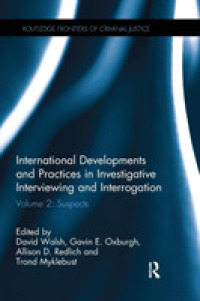基本説明
Examines the critical role that citizens play in guarding against crime.
Full Description
This ground-breaking book examines the critical role that citizens play in guarding against crime. By focusing on the ways in which residents are able to capably guard their residential environments from crime, Reynald shows how local residents function (or fail to function) as effective crime controllers. The studies contained herein are aimed at developing our theoretical, empirical and practical understanding of the function of the capable guardian as a critical, yet elusive actor in the crime event model. In lieu of utilizing secondary data sources for proxy measures, this book argues in favour of new, more direct measures of guardianship, employing direct methods of primary data collection in order to capture the action dimensions of capable guardianship, as well as various other environmental and contextual factors that affect it. It features observations of guardianship in action and interviews with guardians to elucidate the factors that empower guardians to make them capable of crime control.
Contents
Chapter 1 Introduction: Guarding Against Crime; Chapter 2 The Guardians, Guardianship and Defensible Space in Residential Crime Prevention; Chapter 3 1The theoretical review in this chapter was first published in ; Chapter 4 Presenting Guardianship in Action: How Local Residents Guard Against Crime; Chapter 5 1The results presented in this chapter were first published in . Guardianship in action: Developing a new tool for measurement. Crime Prevention and Community Safety: An International Journal. 11(1), 1-20, reproduced with permission of Palgrave Macmillan; Chapter 6 1Results presented in this chapter were first published in ; Chapter 7 1Some of the results presented in this chapter have appeared in ; Chapter 8 Supervision and Residents' Ability to Detect Potential Offenders; Chapter 9 Decision Making by Guardians: Factors Affecting the Decision to Intervene; supplement Supervision, Intervention and the Neighbourhood Context; Chapter 10 Conclusions and Directions for the Future;








